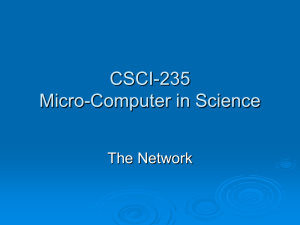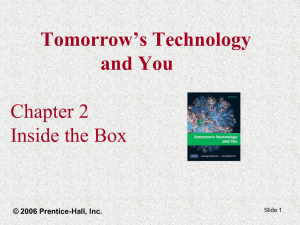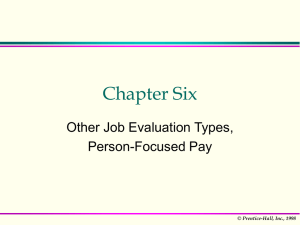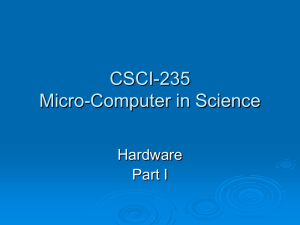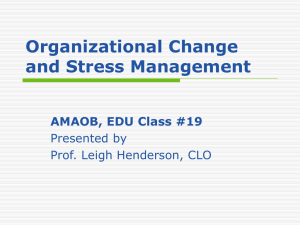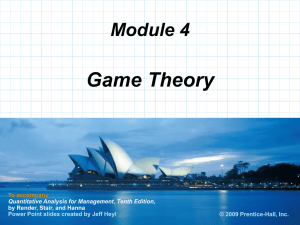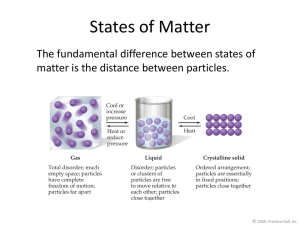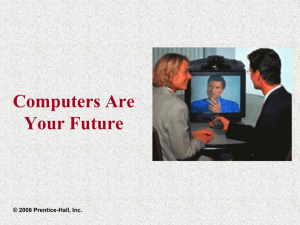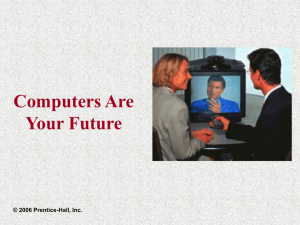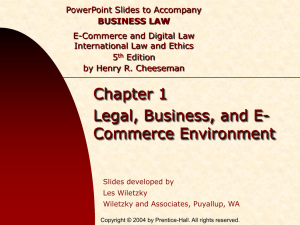Slide 3 Computers Are Your Future Chapter 3
advertisement
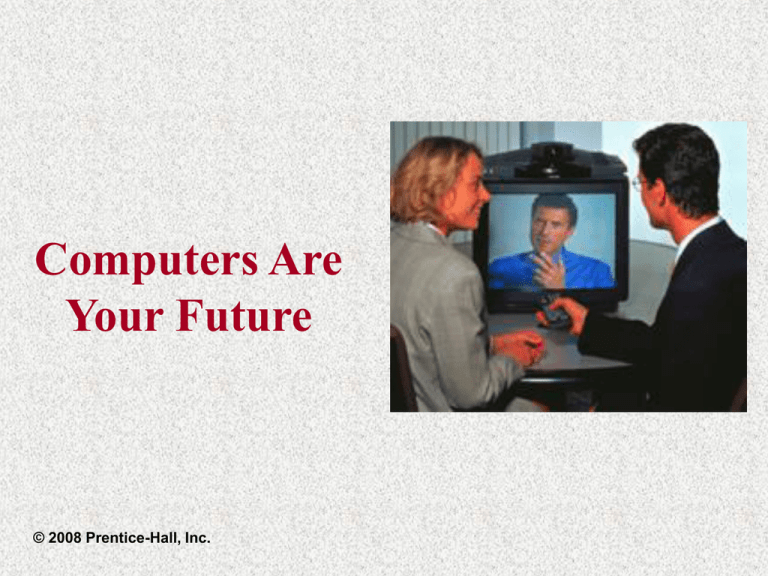
Computers Are Your Future © 2008 Prentice-Hall, Inc. Computers Are Your Future Chapter 3 Computers Are Your Future Chapter 3 Wired & Wireless Communication © 2008 Prentice-Hall, Inc. Slide 2 Computers Are Your Future Chapter 3 What You Will Learn . . . The definition of bandwidth The bandwidth needs of a typical user How modems change digital signals into analog Transmission media and methods Limitations of public switched telephone network (PTSN) for sending and receiving data © 2008 Prentice-Hall, Inc. Slide 3 Computers Are Your Future Chapter 3 What You Will Learn . . . Multiplexing and digital telephony and their impact on line usage Examples of how digitization and convergence are blurring the boundaries between popular communication devices Various wired and wireless applications © 2008 Prentice-Hall, Inc. Slide 4 Computers Are Your Future Chapter 3 Moving Data: Bandwidth and Modems Communications – sending and receiving messages Communications channels – paths through which messages are passed Signals can be: • Analog – data is in continuous waveforms • Digital – data is in discontinuous pulses (0’s & 1’s) digital analog © 2008 Prentice-Hall, Inc. Slide 5 Computers Are Your Future Chapter 3 Moving Data: Bandwidth and Modems Bandwidth – the amount of data that can be transmitted through a given communications channel Analog measured in cycles per second (Hz) Digital measured in bits per second (bps) Broadband – any transmission medium that transports high volumes of data at high speeds © 2008 Prentice-Hall, Inc. Slide 6 Computers Are Your Future Chapter 3 Moving Data: Bandwidth and Modems Modems Transmit data over telephone lines Modulation – converts digital (from computer) to analog to cross telephone lines Demodulation – converts analog (phone lines) to digital for computer © 2008 Prentice-Hall, Inc. Slide 7 Computers Are Your Future Chapter 3 Wireless Transmission Media Wireless transmission media refers to the methods of carrying data through the air or space using infrared, radio, or microwave signals. © 2008 Prentice-Hall, Inc. Slide 8 Computers Are Your Future Chapter 3 Wireless Transmission Media: Infrared Infrared is a wireless transmission medium that carries data via light beams. Transmitter and receiver must be in line of sight. An IrDa port is needed to use infrared with a computer. © 2008 Prentice-Hall, Inc. Slide 9 Computers Are Your Future Chapter 3 Wireless Transmission Media: Radio Radio is a wireless transmission medium that carries data via radio frequency signals. Wireless LANs in a home or business are one type of radio technology. Radio signals can be long range (between cities or regions) and short range (within a building). Radio signals are susceptible to noise and electrical interference. © 2008 Prentice-Hall, Inc. Slide 10 Computers Are Your Future Chapter 3 Wireless Transmission Media: Bluetooth Short-range radio transmission technology Devices identify each other by identification number. Connection is confirmed before it is made final. A line of site is not required. © 2008 Prentice-Hall, Inc. Slide 11 Computers Are Your Future Chapter 3 Wireless Transmission Media: Microwaves Microwaves are highfrequency radio waves Much of long-distance telephone service is carried by microwaves. Microwaves travel in a straight line. Microwave relay stations are built about 30 miles apart. © 2008 Prentice-Hall, Inc. Slide 12 Computers Are Your Future Chapter 3 Wireless Transmission Media: Satellites Satellites are microwave relay stations suspended in space. They use microwave signals to transmit data to and from earth-based microwave relay stations. They are positioned in geosynchronous orbits. © 2008 Prentice-Hall, Inc. Slide 13 Computers Are Your Future Chapter 3 Wired Communication via the PSTN The public switched telephone network (PSTN) is the world telephone system. It is used for data as well as voice communications. Twisted-pair wire and fiber-optic cable provide the connections for the system. Home and business phones are connected to subscriber loop carriers (SLCs). The area serviced by SLCs is called the local loop. © 2008 Prentice-Hall, Inc. Slide 14 Computers Are Your Future Chapter 3 Wired Transmission Media: Twisted Pair Twisted Pair – two insulated wires twisted around each other – used for telephone wires © 2008 Prentice-Hall, Inc. Slide 15 Computers Are Your Future Chapter 3 Wired Transmission Media: Coaxial Cable Coaxial Cable – center copper wire surrounded by insulation, surrounding a layer of braded wire © 2008 Prentice-Hall, Inc. Slide 16 Computers Are Your Future Chapter 3 Wired Transmission Media: Fiber Optic Fiber-optic cable – thin strands of glass that carry data by light pulses © 2008 Prentice-Hall, Inc. Slide 17 Computers Are Your Future Chapter 3 Multiplexing Multiplexing technology enables simultaneous multi-use of transmission lines. Copper wire allows up to 24 simultaneous calls per wire. Fiber-optic cable permits up to 43,384 calls per strand. © 2008 Prentice-Hall, Inc. Slide 18 Computers Are Your Future Chapter 3 Last-Mile Technologies The “last mile” refers to the phone lines that connect homes and businesses to the local loop. The inability of users to access the high-speed fiber-optic cable creates a bottleneck of data called the last-mile problem. © 2008 Prentice-Hall, Inc. Slide 19 Computers Are Your Future Chapter 3 Last-Mile Technologies Digital telephony technologies that use twisted-pair wire are referred to as last-mile technologies. ISDN DSL Cable Modems Leased lines SONET MMDS © 2008 Prentice-Hall, Inc. Slide 20 Computers Are Your Future Chapter 3 Convergence: Is it a Phone or a Computer? Digitization – transformation of data into digital form Convergence – merging of disparate objects or ideas into new combinations © 2008 Prentice-Hall, Inc. Slide 21 Computers Are Your Future Chapter 3 Cellular Telephones Cellular telephones enable calls to be placed through a wireless telecommunications system. Cellular phones use radio or infrared signals. Cells are limited geographic transmission areas. A mobile telephone switching office (MTSO) monitors the signal strength of cellular phones. © 2008 Prentice-Hall, Inc. Slide 22 Computers Are Your Future Chapter 3 Personal Communication Service (PCS) Personal Communication Service (PCS) refers to digital cellular telephone service technologies. Digital cellular phones offer: Noise-free sound Improved coverage Protection from eavesdropping and phone fraud Voice recognition High-speed Internet access © 2008 Prentice-Hall, Inc. Slide 23 Computers Are Your Future Chapter 3 Web-Enabled Devices A Web-enabled device is any device that can display and respond to HTML or XML. PDAs, cell phones, and tablet PCs are Web-enabled devices. © 2008 Prentice-Hall, Inc. Slide 24 Computers Are Your Future Chapter 3 Wired and Wireless Applications Internet telephone – using the Internet for real-time voice communications © 2008 Prentice-Hall, Inc. Slide 25 Computers Are Your Future Chapter 3 Wired and Wireless Applications Videoconferencing – using sound and video technologies to meet with others © 2008 Prentice-Hall, Inc. Slide 26 Computers Are Your Future Chapter 3 Facsimile (Fax) Transmission Fax transmission is the means of sending an image of a document over telephone lines. Fax modems support fax as well as data protocols. © 2008 Prentice-Hall, Inc. Slide 27 Computers Are Your Future Chapter 3 Satellite Radio, GPS Satellite radio - broadcasts are transmitted through a satellite GPS – global positioning systems 27 earth orbiting satellites Used in navigation systems © 2008 Prentice-Hall, Inc. Slide 28 Computers Are Your Future Chapter 3 Text, Picture, and Video Messaging Text messaging – sending text communications over a cell phone Picture messaging – using camera phones to send pictures to other cell phones © 2008 Prentice-Hall, Inc. Slide 29 Computers Are Your Future Chapter 3 Chapter 3 Summary Bandwidth is the data transfer capacity of a communication channel. A modem is used to send digital data over a phone line. Physical and wireless media are used to communicate with technology. The public switched telephone network (PSTN) is mostly digital. © 2008 Prentice-Hall, Inc. Slide 30 Computers Are Your Future Chapter 3 Chapter 3 Summary (continued) Multiplexing is the transmission of more than one communication on a single line. Digitization is the transformation of data into digital form. Internet telephony and faxing can be accomplished through the Internet. © 2008 Prentice-Hall, Inc. Slide 31
